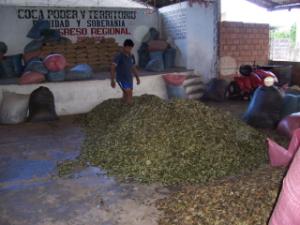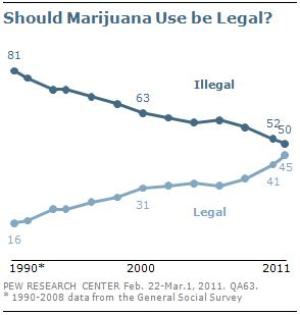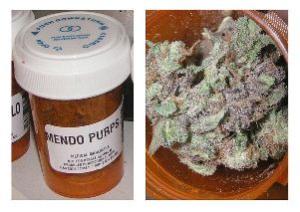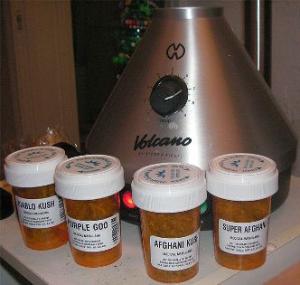2011 was a busy year in drug policy. Here is our selection of the biggest stories of the year here at home.
We go around the world to find the most important international drug policy stories of 2011.
The US Supreme Court has upheld drug dog sniffs of vehicles, luggage at airports, and packages in transit. Now, the state of Florida wants it to uphold a drug dog sniff at your front door.
A lawsuit filed by Arizona Gov. Jan Brewer to block implementation of the state's voter-approved medical marijuana dispensary program was dismissed in federal court Wednesday.
The pain relief movement has lost a true hero. Siobhan Reynolds, founder of the Pain Relief Network and a tireless advocate for the cause, was killed in a plane crash in Ohio on Christmas Eve day.
There has been no holiday break in Mexico's prohibition-related mayhem, but it's now looking like 2011's death toll is going to be down from last year.
Here's the latest from the busy world of medical marijuana.
The Chronicle may have taken a week off, but drug prohibition-related police corruption didn't. Here is two weeks worth of corrupt cops.
Five more US drug war deaths this month bring the year's total to 54.
Events and quotes of note from this week's drug policy events of years past.
We can put 2011 to bed now, but not before looking back one last time at the good, the bad, and the ugly. It was a year of rising hopes and crushing defeats, of gaining incremental victories and fending off old, failed policies. And it was a year in which the collapse of the prohibitionist consensus grew ever more pronounced. Let's look at some of the big stories:
Progress on Marijuana Legalization
Last year saw considerable progress in the fight for marijuana legalization, beginning in January, when
Law Enforcement Against Prohibition (LEAP) got President Obama to say that legalization (in general) is "an entirely legitimate topic for debate," and that while he does not favor it, he does believe in "a public health-oriented approach" to illicit drugs. Before the LEAP intervention, which was made via a YouTube contest, legalization was "not in the president's vocabulary." While we're glad the president learned a new word, we would be more impressed if his actions matched his words. Later in the year, in response to "We the People" internet petitions, the Obama White House clarified that, yes, it still opposes marijuana legalization.
In June, Reps. Barney Frank (D-MA) and Ron Paul (R-TX) made history by introducing the first ever bill in Congress to end federal marijuana prohibition,
H.R. 2306. It hasn't been scheduled for a hearing or otherwise advanced in the legislative process, but it has garnered 20 cosponsors so far. Sadly, its lead sponsors are both retiring after this term.
Throughout the year, there were indications that
marijuana legalization is on the cusp of winning majority support among the electorate. An August Angus Reid poll had support at 55%, while an October Gallup poll had it at 50%, the first time support legalization has gone that high since Gallup started polling the issue. A November CBS News poll was the downside outlier, showing support at only 40%, down slightly from earlier CBS polls. But both the Angus Reid and the Gallup polls disagreed with CBS, showing support for legalization trending steadily upward in recent years.
Legalization is also polling reasonably -- if not comfortably -- well in Colorado and Washington, the two states almost certain to vote on initiatives in November. In December, Public Policy Polling had legalization leading 49% to 40% in Colorado, but that was down slightly from an August poll by the same group that had legalization leading 51% to 38%.
In Washington, a similar situation prevails. A January
KING5/
SurveyUSA poll had 56% saying legalization would be a good idea and 54% saying they supported marijuana being sold at state-run liquor stores (similar to what the I-502 initiative proposes), while a July
Elway poll had 54% either definitely supporting legalization or inclined to support it. But by September, the Strategies 360 Washington Voter Survey had public opinion evenly split, with 46% supporting pot legalization and 46% opposed.
The polling numbers in Colorado and Washington demonstrate that victory at the polls in November is in reach, but that it will be a tough fight and is by no means a sure thing. "Stoners Against Proposition 19"-style opposition in both states isn't going to help matters, either.
Oh, and Connecticut became the 14
th decriminalization state.
Medical Marijuana Advances…
In May,
Delaware became the 16th state to enact a medical marijuana law. Under the law, patients with qualifying conditions can legally possess up to six ounces of marijuana, but they cannot grow their own. Instead, they must purchase it from a state-licensed compassion center. That law will go into effect this year.
Meanwhile, New Jersey and Washington, DC, continue their achingly slow progress toward actually implementing existing medical marijuana laws. In New Jersey,
Gov. Chris Christie (R) finally got out of the way and okayed plans for up to six dispensaries, but early efforts to set them up are running into
NIMBY-style opposition. In DC, a medical marijuana program approved by voters in 1998 (!) but thwarted by Congress until 2009 is nearly at the stage of selecting dispensary operators. One of these months or years, patients in New Jersey and DC may actually get their medicine.
And late in the year, after the federal government rejected a nine-year-old petition seeking to reschedule marijuana, the governors of Rhode Island, Vermont, and Washington formally asked the Obama administration to reschedule it so that states could regulate its medical use without fear of federal interference. As the year came to an end, Colorado joined in the request for rescheduling.
…But the Empire Strikes Back
Last year saw the Obama administration
recalibrate its posture toward medical marijuana, and not for the better. Throughout the year, US Attorneys across the country sent ominous signals that states attempting to regulate medical marijuana dispensaries could face problems, including letters to state governors not quite stating that state employees involved in regulation of the medical marijuana industry could face prosecution. That intimidated public officials who were willing to be intimidated, leading, for example, to New Jersey
Gov. Chris Christie (R) delaying his state's medical marijuana program, Rhode Island
Gov. Lincoln
Chafee (I) to kill plans for dispensaries there, and Washington
Gov. Christine
Gregoire (D) to veto key parts of a bill there that would have regulated dispensaries.
Then the feds hit hard at Montana, raiding dispensaries and growers there, even as the state law was under attack by conservative Republican legislators. Now, Montana medical marijuana providers are heading to federal prison, and the state law has been restricted. What was once a booming industry in Montana has been significantly stifled.
There have also been
raids directed at providers in Colorado, Michigan, Oregon, and Washington, but California has been the primary target of federal attention in the latter half of the year. Since a joint offensive by federal prosecutors in the state got underway in October, with threat letters being sent to numerous dispensaries and their landlords, a great chill has settled over the land. Dispensary numbers are dropping by the day, the number of lost jobs number in the thousands, and the amount of tax revenues lost to local jurisdictions and the state is in the millions. That's not to mention the patients who are losing safe access to their medicine.
It's unclear whether the impetus for the crackdown originated in the Dept. of Justice headquarters in Washington or with individual US Attorneys in the states. Advocates hope it will stay limited mainly to states that are not effectively regulating the industry, and a coalition in California has filed a ballot initiative for 2012 that would do just that. Either way there is plenty of pain ahead, for patients and for providers who took the president's and attorney general's earlier words on the subject at face value.
Synthetic Panic
Last year, Congress and state and local governments across the land set their sights on new synthetic drugs, especially synthetic
cannabinoids ("fake marijuana") and a number of
methcathinone derivatives ("bath salts") marketed for their stimulating effects similar to amphetamines or cocaine. Confronted with these new substances, politicians resorted to reflex
prohibitionism, banning them as fast as they could.
Some 40 states and countless cities and counties have imposed bans on fake weed or bath salts or both, most of them acting this year.
At the federal level, the DEA enacted emergency bans on fake weed -- after first being temporarily blocked by retailers -- and then bath salts until Congress could act. It did so at the end of the year,
passing the Synthetic Drug Control Act of 2011. The bill makes both sets of substances Schedule I drugs under the Controlled Substances Act, which will pose substantial impediments to researching them. Under the bill, prison sentences of up to 20 years could be imposed for the distribution of even small quantities of the new synthetics.
But the prohibitionists have a problem: Synthetic drug makers are responding to the bans by bringing new, slightly different formulations of their products to market. Prosecutors are finding their cases evaporating when the find the drugs seized are not the ones already criminalized, and retailers are eager to continue to profit from the sales of the new drugs. As always, the drug law enforcers are playing catch-up and the new drug-producing chemists are way ahead of them.
The Drug War on Autopilot: Arrests Hold Steady, But Prisoners Decline Slightly

overcrowded Mule Creek State Prison, CA
Last year saw more evidence that drug law enforcement has hit a plateau, as 2010 drug arrests held steady, but the number of prisoners and people under correctional supervision declined slightly.
More than 1.6 million people were arrested for drug offenses in the US in 2010, according to the FBI's
Uniform Crime Report 2010, and more than half of them were for marijuana. That's a drug arrest every 19 seconds, 24 hours a day, every day last year. The numbers suggest that despite "no more war on drugs" rhetoric emanating from Washington, the drug war juggernaut is rolling along on cruise control.
Overall, 1,638,846 were arrested on drug charges in 2010, up very slightly from the 1,633,582 arrested in 2009. But while the number of drug arrests appears to be stabilizing, they are stabilizing at historically high levels. Overall drug arrests are up 8.3% from a decade ago.
Marijuana arrests last year stood at 853,838, down very slightly from 2009's 858,408. But for the second year in a row, pot busts accounted for more arrests than all other drugs combined, constituting 52% of all drug arrests in 2010. Nearly eight million people have been arrested on pot charges since 2000.
The vast majority (88%) off marijuana arrests were for simple possession, with more than three-quarters of a million (750,591) busted in small-time arrests. Another 103,247 people were charged with sale or manufacture, a category that includes everything from massive marijuana smuggling operations to persons growing a single plant in their bedroom closets.
An analysis of the Uniform Crime Report data by the University of Maryland's Center for Substance Abuse Research added further substance to the notion that drug enforcement is flattening. The center found that the arrest rate for drug violations has decreased for the last four years, but still remains more than twice as high as rates in the early
1980s. The all-time peak was in 2006.
Meanwhile, the Bureau of Justice Statistics reported that for the first time since 1972, the US prison population in 2010 had fallen from the previous year and that for the second year in a row, the number of people under the supervision of adult correctional authorities had also declined.
In its report
Prisoners in 2010,
BJS reported that the overall US prison population at the end of 2010 was 1,605,127, a decrease of 9,228 prisoners or 0.6% from year end 2009. The number of state prisoners declined by 0.8% (10,881 prisoners), while the number of federal prisoners increased by 0.8% (1.653 prisoners). Drug offenders accounted for 18% of state prison populations in 2009, the last year for which that data is available. That's down from 22% in 2001. Violent offenders made up 53% of the state prison population, property offenders accounted for 19%, and public order or other offenders accounted for 9%.
In the federal prison population, drug offenders made up a whopping 51% of all prisoners, with public order offenders (mainly weapons and immigration violations) accounting for an additional 35%. Only about 10% of federal prisoners were doing time for violent offenses. Overall, somewhere between 350,000 and 400,000 people were doing prison time for drug offenses last year.
Similarly, in its report
Correctional Population in the US 2010,
BJS reported that the number of people under adult correctional supervision declined 1.3% last year, the second consecutive year of declines. The last two years are the only years to see this figure decline since 1980.
At the end of 2010, about 7.1 million people, or one in 33 adults, were either in prison or on probation or parole. About 1.4 million were in state prisons, 200,000 in federal prison, and 700,000 in jail, for a total imprisoned population of about 2.3 million. Nearly 4.9 million people were on probation or parole.
America's experiment with mass incarceration may have peaked, exhausted by its huge costs, but change is coming very slowly, and we are still the world's unchallenged leader in imprisoning our own citizens.
Federal Crack Prisoners Start Coming Home
Hundreds of federal crack cocaine prisoners began walking out prison in November, the first beneficiaries of a US Sentencing Commission decision to apply retroactive sentencing reductions to people already serving time on federal crack charges. As many as 1,800 federal crack prisoners were eligible for immediate release and up to 12,000 crack prisoners will be eligible for sentence reductions that will shorten their stays behind bars.
The releases come after Congress passed the Fair Sentencing Act in August 2010, which shrank the much criticized disparity between mandatory minimum sentences for crack and powder cocaine from 100:1 to 18:1. After Congress acted, the Sentencing Commission then moved to make those changes retroactive, resulting in the early releases beginning in November.
Despite the joyous reunions taking place across the country, the drug war juggernaut keeps on rolling, and there is much work remaining to be done. Not all prisoners who are eligible for sentence reductions are guaranteed to receive one, and retroactivity won't do anything to help people still beneath their mandatory minimum sentences. A bill with bipartisan support in Congress,
H.R. 2316, the Fair Sentencing Clarification Act, would make Fair Sentencing Act changes to mandatory minimum sentences retroactive as well, so that crack offenders left behind by the act as is would gain its benefits.
And the Fair Sentencing Act itself, while an absolute advance from the 100:1 disparity embodied in the crack laws, still retains a scientifically unsupportable 18:1 disparity. For justice to obtain, legislation needs to advance that treats cocaine as cocaine, no matter the form it takes.
But even those sorts of reforms are reforms at the back end, after someone has already been investigated, arrested, prosecuted, and sentenced. Radical reform that will cut the air supply to the drug war incarceration complex requires changes on the front end.
Also in November, the US Supreme Court announced that it will decide whether the Fair Sentencing Act should be applied to those who were convicted, but not sentenced, before it came into effect -- the so-called "pipeline" cases. The decision to take up the issue came after lower courts split on the issue. The Supreme Court is expected to rule on the issue in June.
Drug Testing the Needy

drug testing lab
With state budgets strained by years of recession and slow recovery, lawmakers across the country are turning their sights on the poor and the needy. In
at least 12 states, bills have been introduced that would require people seeking welfare or unemployment benefits to undergo drug testing and risk losing those benefits if they test positive. Some Republicans in the US Congress want to do the same thing. In a thirteenth state, Michigan, the state health department is leading the charge.
The race to drug test the needy appears to be based largely on anecdotal and apocryphal evidence. South Carolina
Gov. Nikki Hailey (R), to take one example, cited reports that a nuclear installation there couldn't fill vacancies because half the applicants failed drug tests, but had to retract that statement because it was nowhere near to being true. In Florida, where welfare drug testing was briefly underway before being halted by a legal challenge, 96% of applicants passed drug tests, while in an Indiana unemployment drug testing program, only 2% failed.
While such legislation appeals to conservative values, it is having a tough time getting passed in most places, partly because of fears that such laws will be found unconstitutional. The federal courts have historically been reluctant to approve involuntary drug testing, allowing it only for certain law enforcement or public safety-related occupations and for some high school students. When Michigan tried to implement a welfare drug testing program more than a decade ago, a federal appeals court ruled that such a program violated welfare recipients' right to be free from unreasonable searches and seizures.
That ruling has served to restrain many lawmakers, but not Florida
Gov. Rick Scott (R) and the Florida legislature. Scott issued an executive order to drug test state employees, but had to put that on hold in the face of threatened legal challenges. The state legislature passed and Scott signed a bill requiring welfare applicants and recipients to undergo drug testing or lose their benefits.
But the ACLU of Florida and the Florida Justice Institute filed suit in federal court to block that law on the grounds it violated the Fourth Amendment. In October,
a federal judge granted a preliminary injunction preventing the state from implementing it. A final decision from that court and decisions about whether it will be appealed are eagerly awaited.
Marking 40 Years of Failed Drug War

Drug War 40th anniversary demo, San Francisco
June 17 marked forty years since President Richard Nixon, citing drug abuse as "public enemy No. 1," declared a "war on drugs." A trillion dollars and millions of ruined lives later, a political consensus is emerging that the war on drugs is a counterproductive failure. The Drug Policy Alliance led advocates all across the country in marking the auspicious date with a day of action to raise awareness about the catastrophic failure of drug prohibition and to call for an exit strategy from the failed war on drugs. More than 50 events on the anniversary generated hundreds of local and
national stories.
In dozens of cities across the land, activists, drug war victims, and just plain folks gathered to commemorate the day of infamy and call for an end to that failed policy. Messages varied from city to city -- in California, demonstrators focused on prison spending during the budget crisis; in New Orleans, the emphasis was on racial injustice and harsh sentencing -- but the central overarching theme of the day, "No More Drug War!" was heard from sea to shining sea and all the way to Hawaii.
The crowds didn't compare to those who gather for massive marijuana legalization protests and festivals -- or
protestivals -- such as the Seattle
Hempfest, the Freedom Rally on Boston Commons, or the Ann Arbor Hash Bash, or even the crowds that gather for straightforward pot protests, such as 420 Day or the Global Marijuana March, but that's because the issues are tougher. People have to break a bit more profoundly with drug war orthodoxy to embrace completely ending the war on drugs than they do to support "soft" marijuana. That relatively small groups did so in cities across the land is just the beginning.
Congress Reinstates the Federal Ban on Funding Needle Exchanges
Two years ago, after years of advocacy by public health and harm reduction advocates, the longstanding ban on federal funding for needle exchanges was repealed.
Last month, the ban was restored as the Senate took the final votes to approve the 2012 federal omnibus spending bill.
It was a Democratic-controlled House and Senate that rescinded the ban two years ago, and it was House Republicans who were responsible for reinstating it this year. Three separate appropriations bills contained language banning the use of federal funds, and House negotiators managed to get two of them into the omnibus bill passed Saturday.
A Labor-Health and Human Services appropriations bill including the ban on domestic use of federal funds for needle exchanges and a State Department bill including a ban on funding for needle exchange access in international programs both made it into the omnibus bill.
The Centers for Disease Control and Prevention (CDC), American Medical Association, National Academy of Sciences, American Public Health Association, and numerous other scientific bodies have found that
syringe exchange programs are highly effective at preventing the spread of HIV/AIDS and other infectious diseases. Eight federal reports have found that increasing access to sterile syringes saves lives without increasing drug use.
Needle exchange supporters said restoring the ban will result in thousands of Americans contracting HIV/AIDS, hepatitis C or other infectious diseases next year alone.
US Drug War Deaths
As far as we know, nobody has ever tried to count the number of people killed in the US because of the war on drugs. We took a crack at it last year, counting only those
deaths directly attributable to drug law enforcement activities. The toll was 54, including three law enforcement officers.
Most of those killed were shot by police, many of them while in possession of firearms (some in their own homes) and some of them while shooting at police. Some were shot in vehicles after police said they tried to run them down (why is it they never were merely trying to get away?). But not all died at the hands of police -- several died of drug overdoses from eating drugs while trying to evade arrest, several more died from choking on bags of drugs they swallowed, one man drowned after jumping into a river to avoid a pot bust, and another died after stepping in front of a speeding semi-trailer while being busted for meth.
People were killed in "routine traffic stops," SWAT-style raids, and undercover operations. Hardly any of those cases made more than a blip in local media, the two exceptions being the case of Jose
Guerena, an Iraq war vet gunned down by an Arizona SWAT team as he responded to his wife's cry of intruders in his own home, and the case of
Eurie Stamps Sr., a 68-year-old Massachusetts man accidentally shot and killed by a SWAT team member executing a warrant for small-time crack sales.
Our criteria were highly restrictive and absolutely undercount the number of people who are killed by our drug laws. They don't include, for instance, people who overdosed unnecessarily because they didn't know what they were taking or medical marijuana patients who die after being refused organ transplants. Nor do they include cases where people embittered by the drug laws go out in a blaze of glory that wasn't directly drug law-related or cases, like the four men killed last year by Miami SWAT officers during an undercover operation directed at drug house robbers.
The toll of 54 dead, then, is an absolute minimum figure, but it's a start. We will keep track again this year, and look for a report on last year's numbers in the coming weeks.
In Conclusion...
Last year had its ups and downs, its victories and defeats, but leaves drug reformers and their allies better placed than ever before to whack away at drug prohibition. This year, it looks like voters in Colorado and Washington will have a chance to legalize marijuana, and who know what else the new year will bring. At the least, we can look forward to the continuing erosion of last century's prohibitionist consensus.
back to top
The new year is upon us and 2011 is now a year for the history books. But we can't let it go without recognizing the biggest global drug policy stories of the year. From the horrors of the Mexican drug wars to the growing clamor over the failures of prohibition, from the poppy fields of Afghanistan and the Golden Triangle to the coca fields of the Andes, from European parliaments to Iranian gallows, drug prohibition and its consequences were big news this year.
Of course, we can't cover it all. We have no room to note the the emergence of West Africa as a transshipment point for South American cocaine bound for Europe's booming user markets, nor the unavailability of
opioid pain medications in much of the world; we've given short shrift to the horrors of "drug treatment" in Southeast Asia; and we've barely mentioned the rising popularity of synthetic stimulants in European club scenes, among other drug policy-related issues. We'll be keeping an eye on all of those, but in the meantime, here are our choices for this year's most important global drug policy stories:
The Mexican Drug Wars

militarized US-Mexico border
This month marks the fifth anniversary of Mexican President Felipe Calderon's declaration of war on his country's drug trafficking organizations -- the so-called cartels -- and five years in, his policy can only be described as a bloody disaster. The death toll stands at somewhere around 45,000 since Calderon sent in the army and the federal police, but that figure doesn't begin to describe the horror of the drug wars, with their gruesome brutality and exemplary violence.
Mexico's drug wars pit the army and the state and federal police against the cartels, the cartels against each other, and different factions of state, local, and federal police, and even different military commands, aligned with various cartels fighting each other in a multi-sided dance of death. All the violence and corruption has had a corrosive effect on Mexicans' perceptions of personal and public safety and security, as well as on its political system.
It has also tarnished the reputation of the Mexican military. After a two-year investigation,
Human Rights Watch reported last month credible evidence that the security forces, led by the military, were responsible for 170 cases of torture, 39 disappearances and 24 extrajudicial killings in the five states they studied.
And, as the cartels battle each other, the military, and the various police, the violence that was once limited to a handful of border cities has spread to cities across the country. Once relatively peaceful Acapulco has been wracked by cartel violence, and this year, both Veracruz and Monterrey, cities once unaffected by the drug wars, have seen murderous acts of spectacular violence.
Meanwhile, business continues as usual, with drugs flowing north across the US border and voluminous amounts of cash and guns flowing south. Calderon's drug war, which has racked up a $43 billion bill so far (and an additional nearly one billion in US Plan
Merida aid), has managed to kill or capture dozens of cartel
capos, but has had no discernable impact on the provision of drugs across the border to feed America's voracious appetite. Worse, the attempted crackdown on the cartels has led them to expand their operations to neighboring Central American countries where the state is even weaker than in Mexico. Both Guatemala and Honduras have seen significant acts of violence attributed to the cartels this year, while El Salvador and Nicaragua also complain of the increasing presence of Mexican drug trafficking organizations.
There are, however, a couple of positives to report. First, the carnage may have peaked, or at least reached a plateau. It now appears that the 2011 death toll this year, while tremendously high at around 12,000,
didl not exceed last year's 15,000. That would mark the first downturn in the killing since Calderon called out the troops.
Second, the bloody failure of Calderon's drug war is energizing domestic Mexican as well as international calls to end drug prohibition. A
strong civil society movement against the drug war and violence has emerged in Mexico and, sadly, the sorrow of Mexico is now Exhibit #1 for critics of drug prohibition around the world.
Afghanistan: Still the World's Drug Crop Capital

anti-opium abuse posters at a drug treatment center in Kabul (photo by the author)
A decade after the US invaded Afghanistan in a bid to decapitate Al Qaeda and punish the Taliban, the US and NATO occupation drags bloodily on, even as it begins to wind down. And Afghanistan's status as the world's number one opium poppy producer remains unchallenged. In a Faustian bargain, the West has found itself forced to accept widespread opium production as the price of keeping the peasantry out of Taliban ranks while at the same time acknowledging that the profits from the poppies end up as shiny new weapons used to kill Western soldiers and their Afghan allies.
The Afghan poppy crop was down in 2010, not because of successful eradication programs, but because a fungus blighted much of the crop. In 2011, the
UN Office on Drugs and Crime reported that the area under poppy cultivation increased 7%, but that the expected harvest increased 61% because of better yields and would produce about 5,800 metric tons of opium.
The 2010 blight-related poppy shortage led to price increases, which encouraged farmers to plant more poppy and more than doubled the farm-gate value of the crop from $605 million to more than $1.4 billion. Additional hundreds of millions go to traders and traffickers, some linked to the Taliban, others linked to government officials. Last year, US and NATO forces embarked on counter-drug operations aimed at traders and traffickers, but only those linked to the Taliban.
And it's not just opium. According to the
UNODC World Drug Report 2011, Afghanistan is also "among the significant cannabis resin producing countries," producing somewhere between 1,500 and 3,500 metric tons of hash in 2010, with no reason to think it has changed dramatically in 2011. That brings in somewhere between $85 million and $265 million at the farm gate.
A decade after the US invasion, Afghanistan remains the world's largest opium producer by far and possibly the world's largest cannabis producer. Given the crucial role these drug crops play in the Afghan economy, there is little reason to think anything is going to change anytime soon.
The Return of the Golden Triangle
In 2010's roundup of major international drug stories, we mentioned the reemergence of opium production in Southeast Asia's Golden Triangle. In 2011, production has accelerated. According to the
UNODC's Southeast Asia Opium Survey 2011, opium production has been increasing since 2006, but jumped 16% last year.
The region produced an estimated 638 metric tons this year, of which 91% came from Myanmar, with Laos and Thailand producing the rest. The region is now responsible for about 12% of annual global opium production.
The amount of land under poppy cultivation is still only one-third of what it was at its 1998 peak, but has more than doubled from its low point of 20,000 hectares in 2006. More importantly, estimated total production has rebounded and is now nearly half of what it was in 1998. The
UNODC points a finger at chronic food insecurity, weak national governments, and the involvement of government actors, especially in Myanmar.
If Afghanistan does not produce enough opium to satisfy global illicit demand, the countries on the Golden Triangle are standing in the wings, ready to make up the difference.
The Rising Clamor for Legalization

former Mexican president Vicente Fox speaking at the Cato Institute
2011 saw calls for ending drug prohibition growing ever louder and coming from ever more corners of the world. Throughout the year, Latin American leaders, such as Colombian President Juan Manuel Santos and former Mexican President Vicente Fox, have called repeatedly for drug legalization, or at least a serious discussion of it. Although the specifics of their remarks shift over time -- sometimes it's a call for drug legalization, sometimes for marijuana legalization, sometimes for decriminalization -- leaders like Fox and Santos are issuing a clarion call for fundamental change in global drug policies.
That such calls should come from leaders in Colombia and Mexico is no surprise -- those are two of the countries most ravaged by drug prohibition and the violence it fuels. By the fall, even current Mexican President Felipe Calderon, who unleashed Mexico's drug war five years ago, was starting to join the chorus. In
an October interview with Time magazine, Calderon said he could never win in Mexico if Americans don't reduce demand or "reduce at least the profits coming from the black market for drugs." While he was unwilling to take the final step and embrace ending prohibition, he added that "I want to see a serious analysis of the alternatives, and one alternative is to explore the different legal regimes about drugs."
But the biggest news in the international battle to end drug prohibition came at mid-year, when the
Global Commission on Drug Policy, a star-studded panel of former presidents and prime ministers, public intellectuals, and business magnates, called the global war on drugs "a failure" and urged governments worldwide to should shift from repressive, law-enforcement centered policies to new ways of legalizing and regulating drugs, especially marijuana, as a means of reducing harm to individuals and society, in a
report that drew press attention from around the world.
The commission, heavily salted with Latin American luminaries, grew out of the previous year's
Latin American Initiative on Drug Policy and includes some of the same members, including former Brazilian President Henry
Cardoso and former Mexican President Ernesto
Zedillo. It is paired with the UK-based
Beckley Foundation's
Global Initiative for Drug Policy Reform, which launched in November and is eyeing changes in the legal backbone of international drug prohibition, the UN 1961 Single Convention on Narcotic Drugs and its successor treaties. The global commission also picked up strong support from an organization of Latin American judicial figures, Latin Judges on Drugs and Human Rights, which echoed the commission's call with its own
Rome Declaration.
European Reforms

wall paintings near the entrance to Christiania, Copenhagen (wikipedia.org)
Drug reform continued its achingly slow progress in Europe in 2011, with a handful of real advances, as well as a number of parties in various countries taking strong drug reform stands. But while Europe has largely embraced harm reduction and seen the positive results of Portugal's decade-long experiment with drug decriminalization, getting to the take level -- ending drug prohibition -- remains elusive.
In March, Scotland's Liberal Democrats
voted to making campaigning for heroin maintenance treatment part of their party platform. Heroin users should not be fined or imprisoned, but should be given the drug through the National Health Service, party members agreed.
In September, their more powerful brethren, the British Liberal Democrats, who are junior partners with the Conservatives in the governing coalition, did them one better by
adopting a resolution supporting the decriminalization of drug possession and the regulated distribution of marijuana and calling for an "impact assessment" of the 1971 Misuse of Drugs Act that would provide a venue for considering decriminalization and controlled marijuana sales. That is going to lead to debate in parliament on the issue next year.
In August, the
Greek government proposed drug decriminalization in a bill sent to parliament by Justice Minister
Miltadis Papioannou. Under the proposed bill, drug possession for personal use would qualify only as "misconduct" instead of a more serious criminal offense. The bill would also guarantee the right to drug treatment, including for people currently imprisoned. People deemed "addict offenders" by the courts would be provided treatment instead of being jailed. But given the other pressing matters before the Greek government, the bill has yet to move.
Probably the most significant actual drug reform achievement in Europe in 2011 was Poland's passage of a law that allows prosecutors to divert drug users into treatment instead of prison.
That law went into effect in December. The new law lets prosecutors bypass the courts in a "treat, not punish" approach to drug use when confronted with people arrested in possession of small amounts of drugs. A person arrested with personal use quantities of drugs can now be immediately referred to a therapist, and prosecutors are compelled to gather information on the extent of the person's drug problem. Still, there is an appetite for more reform; a political party that wants legalize soft drugs won 10% of the vote in the October presidential elections.
There has been some movement on marijuana and hints of more to come, as well in 2011. In an otherwise dismal year for weed in the Netherlands (see below),
the Dutch high court ruled in April that anyone can grow up to five pot plants without facing criminal charges, no matter how big the harvest. The ruling came after prosecutors went after two different people who produced large multi-pound yields from a handful of plants, arguing that such harvests violated the Dutch five-gram rule. The court disagreed, but said that the pot would have to be turned over to police if they came to the door.
In June,
Italy's top court ruled that balcony pot grows are okay, finding that the amounts of pot produced in such grows "could cause no harm." It's a small advance on earlier court rulings, and a step in the right direction.
And then there are moves that are pushing the envelope. Last month,
the Copenhagen city council voted to explore how best to legalize and regulate pot sales. The move has the support of the mayor, but has to be approved by the Danish parliament, which has balked at such measures before. Maybe this time will be different. And raising the ante,
the Basque parliament is set to approve a new drug law that will regulate marijuana cultivation, distribution, and consumption. The move is being propelled by the health ministry in the autonomous region of Spain, and would be a direct challenge to the UN conventions' ban on legalization.
Medical Marijuana's Slowly Growing Global Acceptance
It comes by dribs and drabs, but it comes.
In Israel,
the Cabinet approved guidelines in August that will govern the supply of marijuana for medical and research purposes. In so doing, it explicitly agreed that marijuana does indeed have medical uses. The move came on the heels of
a Health Ministry decision the week before to deal with supply problems by setting up a unit within the department to grow medical marijuana. That unit will begin operating in January 2012. Currently, medical marijuana is supplied by private Israeli growers, but with the number of medical marijuana patients expected to rise from the current 6,000 to 40,000 by 2016, the state is stepping in to help out with supply.
In the Czech Republic,
the Ministry of Health said in September it plans to remove marijuana from its list of proscribed substances and allow it to be prescribed by doctors. The ministry said it would move to amend Czech drug laws by the end of the year to allow for the prescription of marijuana by doctors, although we haven't seen that actually happen yet. The ministry must also determine what sort of distribution system to set up. The Israeli model, where the state is licensing medical marijuana farms, is one oft-cited system.
In New Zealand,
medical marijuana was on the agenda of the New Zealand Law Commission when it issued a report in May reviewing the country's drug laws. In addition to other drug reform measures, the commission called for clinical trials on medical marijuana "as soon as practicable" and said medical marijuana patients should not be arrested in the meantime. "Given the strong belief of those who already use cannabis for medicinal purposes that it is an effective form of pain relief with fewer harmful side effects than other legally available drugs, we think that the proper moral position is to promote clinical trials as soon as practicable. We recommend that the government consider doing this." The government there does not appear to be eager to follow those recommendations, but the commission report is laying the groundwork for progress.
In Canada, which has an existing medical marijuana program, the news is more mixed. Health Canada is in the process of adopting a "more traditional regulatory role" for the medical marijuana "marketplace, and envisions privatized medical marijuana provision by licensed and strictly regulated grower. That doesn't sit well with a lot of patients and activists because it means Health Canada wants to eliminate patients' ability to grow their own. Nor were patients particularly impressed with Health Canada's earlier attempt to provide privately produced and licensed medical marijuana. Without outright legalization of marijuana being more popular than the Conservative government, Canada may eventually get around to solving its medical marijuana problem by just legalizing it all.
Iran's Drug War Execution Frenzy

drug burn marking International Anti-Drugs Day, Tehran
Iran has garnered itself a well-deserved reputation as one of the world's leading practitioners of the death penalty, but 2011 saw an absolute explosion of death sentences and executions -- the vast majority of them for drug offenses. At the end of January, we reported that
Iran had already executed 56 drug offenders for offenses involving more than five kilograms of opium or 30 grams of heroin. As if that weren't enough, in February,
the Islamic Republic made trafficking in synthetic drugs, including meth, a capital offense. More than 50 grams (less than two ounces) of meth could bring the death penalty, but only on a second offense.
At the end of May, by which time the execution toll for drug offenses had risen to 126,
Iran announced it had 300 drug offenders on death row and lashed out at Western critics, saying if the West was unhappy with the killings, Iran could simply quit enforcing its drug laws.
"The number of executions in Iran is high because 74% of those executed are traffickers in large quantities of opium from Afghanistan bound for European markets," said Mohammad
Javad Larijani, head of Iran's Supreme Council for Human Rights, during a
press conference that month. "There is an easy way for Iran and that is to close our eyes so drug traffickers can just pass through Iran to anywhere they want to go," he said."The number of executions in Iran would drop 74%. That would be very good for our reputation."
In a December report,
Amnesty International condemned Iran's drug executions, saying the Islamic Republic has embarked on "a killing spree of staggering proportions." The London-based human rights group said "at least 488 people have been executed for alleged drug offenses so far in 2011, a nearly threefold increase on the 2009 figures, when Amnesty International recorded at least 166 executions for similar offenses."
"To try to contain their immense drug problem, the Iranian authorities have carried out a killing spree of staggering proportions, when there is no evidence that execution prevents drug smuggling any more effectively than imprisonment," said Amnesty's Interim Middle East and North Africa deputy director, Ann Harrison. "Drug offenses go much of the way to accounting for the steep rise in executions we have seen in the last 18 months," Harrison said.
Amnesty said it began to receive credible reports of a new wave of drug executions in the middle of 2010, including reports of mass executions at
Vakilabad Prison in
Mashhad, with one, on August 4, 2010, involving at least 89 people. While Iran officially acknowledged 253 executions in 2010, of which 172 were for drug offenses, Amnesty said it has credible reports of another 300 executions, "the vast majority believed to be for drug-related offenses."
"Ultimately, Iran must abolish the death penalty for all crimes, but stopping the practice of executing drug offenders, which violates international law, would as a first step cut the overall number significantly," said Harrison.
Amnesty also accused Iran of executing people without trial, extracting confessions by torture, failing to notify families -- or sometimes, even inmates -- of impending executions, and mainly executing the poor, members of minority groups, or foreigners, including large numbers of Afghans.
Amnesty noted tartly that Iran receives significant international support in its war on drugs. The
UN Office on Drugs and Crime has provided $22 million since 2005 to support training for Iranian anti-drug forces, while the European Union is providing $12.3 million for an Iran-based project to strengthen regional anti-drug cooperation. Belgium, Denmark, France, Germany, Ireland, and Japan have all provided anti-drug assistance to Iran via
UNODC programs.
"All countries and international organizations helping the Iranian authorities arrest more people for alleged drugs offenses need to take a long hard look at the potential impact of that assistance and what they could do to stop this surge of executions," said Harrison. "They cannot simply look the other way while hundreds of impoverished people are killed each year without fair trials, many only learning their fates a few hours before their deaths."
Iran may be the most egregious offender when it comes to killing drug offenders, but it is by no means the only one. Other countries that not only have the death penalty for drug offenses but actually apply it include China, Malaysia, Saudi Arabia, Singapore, and Vietnam. Human rights activists argue that the death penalty for drug offenses violates the UN Charter. For information on ongoing efforts to curtail the use of the death penalty for drug offenses, visit the International Harm Reduction Association's
Death Penalty Project.
In a bit of good news on the death penalty front, in June,
India's Bombay High Court struck down a mandatory death penalty for some drug offenses.The regional high court is the equivalent of a US district court of appeals.
"This is a positive development, which signals that courts have also started to recognize principles of harm reduction and human rights in relation to drugs. It is not utopia, but it is a giant step," said Indian Harm Reduction Network head Luke Samson.
"The Court has upheld at the domestic level what has been emphasized for years by international human rights bodies -- capital drug laws that take away judicial discretion are a violation of the rule of law," said Rick Lines, executive director of
Harm Reduction International (formerly the International Harm Reduction Association) and author of
The Death Penalty for Drug Offenses: A Violation of International Human Rights Law. "India's justice system has affirmed that it is entirely unacceptable for such a penalty to be mandatory. This will set a positive precedent for judicial authorities in the region, which is rife with
draconian drug laws."
Weekly updates on executions worldwide including for drug offenses are available from the Rome-based group
Hands Off Cain.
The Netherlands Will Bar Foreigners from its Cannabis Cafes... and More

a coffee shop in Amsterdam (wikimedia.org)
The Netherlands' conservative coalition government of Prime Minister Mark
Rutte continued and deepened its effort to undo Holland's reputation as a marijuana haven and drug tourism destination last year. Plans to ban foreigners from Dutch cannabis cafes reached fruition in 2011, with
the Dutch Justice Ministry saying in November that foreigners would be barred from southern border coffee shops effective January 1. A month later, the government announced that plan would be delayed until May, and would go into effect nationwide beginning in 2013. Goodbye, tourist dollars.
But it's not just clamping down on foreigners. The number of coffee shops operating in the country has dropped by about half from its peak, with local governments putting the squeeze on them via measures such as distance restrictions (must be so far from a school, etc.). Now, the national government will be limiting their client base to 2,000 card carrying Dutch nationals each.
The national government also rather bizarrely declared in October that
it wanted to declare high-potency marijuana a dangerous drug like cocaine or heroin and ban its possession or sale. That hasn't happened yet, but unless the Dutch get around to electing a more progressive government, the Christian Democrats and their allies will continue to work to undo the country's progressive pot policy reputation, not to mention its tourism industry..
North America's Only Supervised Injection Site Gets a Reprieve
Ending a years' long effort by the Conservative government of Prime Minister Steven Harper to close
Insite, the Vancouver supervised injection site for hard drug users,
the Supreme Court of Canada ruled unanimously in September that it should be allowed to stay open.
The Harper government, a foe of harm reduction practices in general and safe
inection sites in particular, had argued that the federal drug law took precedence over British Columbia's public health policies. British Columbia and other
Insite supporters argued that because
Insite is providing a form of health care, its operation is a provincial matter. The federal government's concerns did not outweigh the benefits of
Insite, the court said.
"The grave consequences that might result from a lapse in the current constitutional exemption for
Insite cannot be ignored," the court said. "
Insite has been proven to save lives with no discernible negative impact on the public safety and health objectives of Canada."
Insite has been the only supervised injection site on the North American continent, but in the wake of that ruling, that may not be the case for long. In the wake of the September ruling,
Montreal announced plans for four safe injection sites in December. It's not a done deal -- it will require financing from provincial health agencies -- but plans are moving forward. And there are distant rumblings of plans for an effort to get a supervised injection site running in San Francisco, which would be a first for the US, but don't hold your breath on that one.
If the Harper government has been defeated in its effort to kill supervised injection sites, it is moving forward with plans to pass an omnibus crime bill that includes mandatory minimum sentences for some drug offenses, including growing as few as six pot plants. With an absolute majority in a parliamentary system, there seems to be no way to block the bill's passage, which will mean a real step backward for our northern neighbor as it emulates some of our worst penal practices.
Bolivia Challenges the Global Coca Ban

coca leaves drying in warehouse, Ayacucho province (photo by the author)
At the end of June, the Bolivian government of former coca-grower union leader
Evo Morales announced
it was resigning from the UN 1961 Single Convention on Narcotic Drugs because that treaty bans the cultivation of coca. The resignation is effective January 1. The move came after a failed effort last year by Bolivia to amend the treaty to allow for coca cultivation, a traditional activity in the Andes, where the plant has been used as a mild stimulant and hunger suppresser for millennia.
"This is an attempt to keep the cultural and inoffensive practice of coca chewing and to respect human rights, but not just of indigenous people, because this is an ancient practice of all Bolivian people," Foreign Minister David
Choquehuanca told the British newspaper
The Guardian at the time.
Bolivia will rejoin the convention sometime during the new year, but with the reservation that it does not accept the language proscribing the coca plant.
That move has aroused the concern of the International Narcotics Control Board, which issued a statement saying the international community should reject moves by any country to quit the treaty and return with reservations doing so "would undermine the integrity of the global drug control system."
Of course, there are many people aside from
Evo Morales who believe the global drug control system lacks any integrity whatsoever. For those people, the actions of Bolivia represent the first serious effort to begin to undo the legal backbone of the global prohibition system.
Morales himself said last month that he believes Bolivia will succeed next year. "I am convinced that next year we will win this international 'fight' for the recognition of chewing coca leaves as a tradition of peoples in Latin America, living in the Andes," he said in an interview with the Bolivian radio station Patria
Nueva.
In ending...
Global drug prohibition is under sustained, systemic, and well-deserved attack. It is being attacked (finally) in its core treaties and institutions, it is under ever broader political attack from around the planet; its central precepts are increasingly tattered. Ever year the clamor grows louder in the face of prohibition's screaming failure to accomplish its given ends and the terrible costs it generates. The process of chipping away at drug prohibition is under way. The prohibitionist consensus is crumbling; now comes the struggle to finally kill the beast and replace it with a more sensible, compassionate, and smarter approach to mind-altering substances.
back to top
The state of Florida is asking the US Supreme Court to reverse a ruling by the Florida Supreme Court that having a drug dog sniff the front door of a residence is a violation of the Fourth Amendment's proscription against unreasonable searches. Court followers told the Associated Press the high court is likely to take up the case.

drug dog (wikimedia.org)
In
Florida v. Jardines, a case that originated with the arrest and conviction of
Joelis Jardines for marijuana trafficking and electricity theft after a Florida police officer's drug dog sniffed at
Jardines' front door and alerted to the odor of marijuana, the state Supreme Court held that the drug dog sniff was indeed a search under the Fourth Amendment and thus required either probable cause or reasonable suspicion if conducted without a search warrant.
The justices could decide this month whether to take the case, the latest dispute about whether the use of dogs to find drugs, explosives and other illegal or dangerous substances violates the Fourth Amendment protection against illegal search and seizure. In previous cases, the Supreme Court has upheld the use of drug-sniffing dogs during traffic stops, at airport luggage inspections, and for shipped packages in transit.
This case is different because it involves a private residence. The Supreme Court has repeatedly emphasized that a residence is entitled to greater privacy than cars on a highway, luggage at an airport, or a package in transit. The court used that reasoning in a 2001 case involving the use of thermal imaging to detect heat from a marijuana grow operation in a home, ruling that the scan constituted a search requiring either a search warrant or probable cause.
"We have said that the Fourth Amendment draws a firm line at the entrance to the house," the court held in that case,
Kyllo v. United States. The opinion noted that thermal imaging could detect such private matters as "at what hour each night the lady of the house takes her daily sauna and bath."
Jardines and his attorney challenged the search, claiming the dog sniff was an unconstitutional intrusion into his home. The trial judge agreed, throwing out the evidence, but an appeals court reversed the lower court decision. In April, in a split decision, the state Supreme Court reversed the appeals court, siding with the trial judge.
Now, attorneys for Florida are seeking US Supreme Court review. They argue that the state Supreme Court decision conflicts with previous rulings that a drug dog sniff is not a search.
"A dog sniff of a house reveals only that the house contains drugs, not any other private information about the house or the persons in it," wrote Carolyn
Snurkowski, Florida associate deputy attorney general. "A person has no reasonable expectation of privacy in illegal drugs."
back to top
A federal judge Wednesday threw out a lawsuit filed on behalf of Arizona Gov. Jan Brewer (R) that had blocked the implementation of the state's voter-approved medical marijuana dispensary program. Brewer and state health officials had sued to ask the court for clarification about whether the state's medical marijuana law was preempted by federal drug laws, saying they feared going forward would put state employees at risk of federal prosecution.
But US District Court Judge Susan Bolton dismissed the lawsuit, saying the state had not shown that federal prosecutors there had threatened to prosecute state or local employees for following the law, nor had it shown that any harm would come absent a ruling from the court.
"Plaintiffs do not challenge any specific action taken by any defendant," Bolton wrote. "Plaintiffs also do not describe any actions by state employees that were in violation of (the Controlled Substances Act) or any threat of prosecution for any reason by federal officials. These issues, as presented, are not appropriate for judicial review."
Brewer spokesman Matthew Benson told the
Arizona Republic the governor was consulting with Attorney General Tom Horne before deciding whether to appeal. He also criticized the decision.
"What this court has essentially said is that it won't hear the state's lawsuit unless and until a state employee faces federal prosecution for enforcing Proposition 203," Benson said. "The federal court has essentially punted on the issue."
The ruling came in response to a motion to dismiss filed by the ACLU, which welcomed the decision and called on Brewer to quit being an obstacle.
“It is unconscionable for
Gov. Brewer to continue to force very sick people to needlessly suffer by stripping them of the legal avenue through which to obtain their vital medicine," said Ezekiel Edwards, director of the ACLU Criminal Law Reform Project. "Today's ruling underscores the need for state officials to stop playing politics and implement the law as approved by a majority of Arizona voters so that thousands of patients can access the medicine their doctors believe is most effective for them."
Under Arizona's medical marijuana law, passed in 2010, patients registered with the state are supposed to be able to obtain medical marijuana from tightly-regulated dispensaries, but that hasn't happened yet. Now, one more hurdle has been removed.
back to top
Prominent pain patient advocate and Pain Relief Network founder Siobhan Reynolds, 50, was killed in a plane crash on Christmas Eve day. She was one of three people aboard a small private plane attempting to land at an Ohio airport that afternoon. The plane missed the runway and instead crashed on a parallel road, killing all aboard.
For the last decade, Reynolds had been a fierce advocate for patients suffering chronic pain and the doctors who attempted to treat them with high-dose
opioid pain medication protocols. She came to be an advocate through personal tragedy -- her husband, a chronic pain patient, died as the family moved cross-country seeking effective relief for him.
But Reynolds turned her personal tragedy into activism of the highest sort, founding the Pain Relief Network to advocate for an effective response to the under-treatment of pain in this county. She was present for the trial of Northern Virginia pain management pioneer Dr. William
Hurwitz, a trial I attended and where we first met.
Hurwitz was convicted of being a drug dealer and imprisoned, an injustice that only deepened Reynolds' fire for justice.
She and the Pain Relief Network played a central role in winning freedom for Richard
Paey, the wheelchair-bound pain patient sentenced to 25 years in state prison, and that was just one of her many interventions in the DEA's war pain doctors. Where the DEA saw only "pill mills" and Dr.
Feelgoods, Reynolds saw the effectiveness with which high-dose
opioid theory brought relief to suffering people.
Her feisty and tireless advocacy brought her into direct conflict with the DEA and federal prosecutors, most notably in the case of Kansas pain clinic owner Dr. Steven
Scheider, who was charged with over-prescribing pain pills, and his wife, Linda, a nurse who was charged along with him. When Reynolds set up shop in Kansas to publicize the case and the issues and lend support to the
Schneiders, Assistant US Attorney Tanya
Treadway opened a criminal investigation into Reynolds and the Pain Relief Network, seeking, among other things, all of Reynolds' email, phone records, and other communications with doctors, patients, and attorneys.
As always, Reynolds fought back against the feds, and, in a shameful episode in American jurisprudence, she lost -- and worse. Not only was she forced to comply with
Treadway's subpoena, but
Treadway and the federal courts conspired to hide the whole sordid episode from public view. The ruling in the case has never been published, nor are the briefs available for scrutiny. Reynolds was even barred from sharing the briefs she submitted with the press.
That ruling was the last straw for the Pain Relief Network, which Reynolds announced was being dissolved a year ago. But not for Reynolds. I spoke with her earlier this year, and she was planning to form another pain advocacy organization. It is our loss that she never got the chance.
Siobhan Reynolds wasn't always easy to work with because she was a true believer in her issue. She was impatient with potential allies who were not willing to go as far as she was, whether they were physicians groups or academics or drug reformers. She wanted the Controlled Substances Act abolished as an abomination, and if you weren't ready to go there, she didn't really want to waste her time with you. But sometimes a movement needs a determined, fiery-eyed idealist. Siobhan Reynolds was that person for the movement against the under-treatment of chronic pain.
back to top
by Bernd Debusmann Jr.
Mexican drug trafficking organizations make billions each year smuggling drugs into the United States, profiting enormously from the prohibitionist drug policies of the US government. Since Mexican president Felipe Calderon took office in December 2006 and called the armed forces into the fight against the so-called cartels, prohibition-related violence has killed more than 45,000 people, including more than 15,000 last year and approximately 12,000 this year. The increasing
militarization of the drug war and the arrest or killing of dozens of high-profile drug traffickers have failed to stem the flow of drugs -- or the violence -- whatsoever. The
Merida initiative, which provides $1.4 billion over three years for the US to assist the Mexican government with training, equipment and intelligence, has so far failed to make a difference. Here are a few of the latest developments in Mexico's drug war:
Thursday, December 22
In Veracruz, suspected
Zetas attacked three passenger buses with gunfire and a grenade in an apparent robbery spree, killing eleven people. Three of the dead were later confirmed to be US citizens who were visiting relatives in Mexico for the holidays. The army later announced that it killed the five gunmen after they were shot at attempting to arrest them.
Friday, December 23
In
Culiacan,
army commandos captured the head of security for the Sinaloa Cartel. Felipe Cabrera
Sarabia, "The Engineer," is thought to have run cartel operations in Durango and in part of Chihuahua. No shots were fired during the arrest operation. Over the course of 2011, Cabrera was involved in a bloody dispute with another
Sinaloa Cartel faction in the state of Durango.
In the port of
Manzanillo, authorities seized 21 metric tons of precursor chemicals used to produce crystal meth on a ship headed towards Guatemala.
In
Tampico Alto, Veracruz,
ten bodies were discovered. The bodies all bore signs of having been tortured and several were decapitated.
In Los
Mochis,
Sinaloa, three decapitated bodies were discovered at a location where the body of a municipal police officer was found on December 18
th.
Saturday, December 24
In
Michoacan,
the body of a teenage American citizen was found in the trunk of a burned car along with two others. The teenager, Alex
Uriel Marron, 18, was reportedly from the Chicago area and visiting family in the village of
Quiringuicharo.
In Saltillo,
Coahuila, three
gunmen were killed in a fire fight with police. A fourth person was wounded. Several assault rifles were confiscated from a car in which the gunmen were traveling.
Sunday, December 25
In Tamaulipas,
authorities discoved 13 bodies in an abandoned truck just across the state border from Veracruz. A banner left with the bodies indicated that the killings were due to an ongoing cartel battle for control of the Veracruz region.
Tuesday, December 27
In Mexico City,
the leader of a small cartel was arrested at the airport. Luis Rodriguez Olivera, "Whitey," is thought to have been head of the "Blondies" Organization which has been allied to several larger cartels. US authorities were offering a $5 million reward for his capture, and accuse him and a brother of smuggling cocaine and meth to the US and to Europe.
In Nuevo Leon, police discovered seven bodies buried in a shallow pit or in a well. The bodies, which were found in Linares and Montemorelos, were discovered using information provided by a group of captured kidnappers alleged to be Zetas.
In Sinaloa,
a former high-ranking federal police official was sentenced to 10 years for helping the Sinaloa Cartel. Javier Herrera Valles was arrested in 2008, although the arrest was controversial because he had recently accused some of his commanding officers of corruption or incompetence.
Wednesday, December 28
In Michoacan,
six gunmen were killed in two separate clashes with the army. In the first, which took place Wednesday night, three men were killed after encountering an army patrol in the Buenavista Tomatlan area. Later, early Thursday morning, another three were killed in a nearby village. All the dead men are thought to be members of the Knights Templar Organization, which is active in the area. In 2011, troops in 21
st military district in Michoacan shot dead a total of 91 gunmen from several organizations.
In Ciudad Juarez,
a leading cartel enforcer was arrested by police. Arturo Bautista, 31, "El Mil Amores," is thought to be a high-ranking member of La Linea, the enforcement arm of the Juarez Cartel. It is unclear, however, if that is his real name. He has been identified as a resident of El Paso, Texas. Bautista was arrested along with three other men after the murder of a woman whom police say was thought to have been passing intelligence to a rival criminal group.
Friday, December 30
In Veracruz,
the Zetas hung up a banner stating they were not responsible for the December 22 bus attacks which killed at least seven people, including three US citizens. The banners claim that corrupt police officers were responsible for the attacks.
In Coahuila,
seven suspected Zetas were captured by the army on the Saltillo-Torreon highway. One of the men was identified as a high-ranking member, but the army has so far not identified him.
Saturday, December 31
In Ciudad Juarez,
at least four people were murdered in several incidents. According to researcher Molly Molloy, this brings the city’s 2011 homicide numbers to 1,980 for the year. This is nearly 40% lower than the 3,622 murders that took place in 2010, but still considerably higher than the 2008 total of 1,623. In total, since 2007, 10,299 homicides have taken place in Ciudad Juarez. February was the bloodiest month in 2011, with 231 murders having taken place.
Sunday, January 1
In Mexico City, the
National Human Rights Commission said that they concluded that five men held in connection with a July 2010 car bombing in Ciudad Juarez had been tortured to obtain confessions. They recommended that six federal police officers and a doctor be questioned in relation with the incident. The men were also accused of the killings of two federal agents. Although cleared in those incidents, the men remain incarcerated on narcotics and weapons charges.
Tuesday, January 3
In Sonora,
at least five people were murdered. In one incident, the bodies of three young men were found on the side of a highway. In another part of the state, two men were found dead in a bullet-riddled truck. Several weapons, including an AK-47 were found in the truck.
Drug-related violence was confirmed in at least six other states, with nine people confirmed dead.
[Editor's Note: Our 2011 estimated death toll is 12,150, pending the release of official figures.Our new 2012 death toll is also an estimate.]
Total Body Count for 2007 (approx.): 4,300
Total Body Count for 2008 (approx.): 5,400
Total Body Count for 2009 (approx.): 9,600
Total Body Count for 2010 (official): 15,273
Total Body Count for 2011 (approx.): 12,150
Total Body Count for 2012: (approx.) 15
TOTAL: > 46,000
back to top
Here's the latest from the medical marijuana skirmishes:
Arizona
A federal judge Wednesday threw out a lawsuit filed on behalf of Arizona Gov. Jan Brewer (R) that had blocked the implementation of the state's voter-approved medical marijuana dispensary program. Brewer and state health officials had sued to ask the court for clarification about whether the state's medical marijuana law was preempted by federal drug laws, saying they feared going forward would put state employees at risk of federal prosecution.
California
On December 21, California Attorney General Kamala Harris sent a letter to top lawmakers in which she warned that any efforts to regulate medical marijuana via the legislative process will be limited by the state constitution and by the federal government's enforcement of the Controlled Substances Act. In the letter, she noted that an appeals court ruling (Pack v. Superior Court) found that state regulation of large scale medical marijuana cultivation "stands as an obstacle to federal enforcement efforts and is therefore preempted by the Federal Controlled Substances Act."
But Harris also noted that because Proposition 215 was enacted by voter initiative, any legislative regulation that would "undo what the people have done" would be unconstitutional under state law. Still, Harris wrote, the legislature needs to intervene because there are "significant unresolved legal questions" regarding parts of the initiative that allow for collaborative cultivation and the legality of dispensaries.
"I hope that the foregoing suggestions are helpful to you in crafting legislation," Harris concluded. "California law places a premium on patients' rights to access marijuana for medical use. In any legislative action that is taken, the voters' decision to allow physicians to recommend marijuana to treat seriously ill patients must be respected."
Also on December 21, the Happy Wellness Center in Newark reopened a week after being raided by state agents. "There's no way that me, the way I am, could just sit back and not open," said the center's CEO, Justin Hammer. "If I felt we were doing anything wrong, anything illegal, I wouldn't be here." The Happy Wellness Center operated for 105 days before the raid and originally opened before the city ban on such operations. An attorney for the collective says only a court order will change their position.
On December 23, the Sacramento County Sheriff's Department returned 2 pounds of medicinal marijuana to a dispensary from which it was seized earlier this month. The move came after a Superior Court judge the same day ordered them to return the medicine. It had been seized in a December 1 raid at the Common Roots Collective.
On December 23, two Long Beach dispensary operators, Jon Grumbine and Joseph Byron, were found guilty of marijuana trafficking after prosecutors argued the men operated the businesses for profit, which is forbidden under state law.
On December 26, medical marijuana patients rallied and marched in San Diego to protest the federal crackdown and recalcitrant local authorities. A crowd of 50 to 75 people showed up, including Democratic Congressman Bob Filner, who is running for mayor.
On December 28, Riverside County officials said they had begun legal action to close down about three dozen dispensaries in unincorporated areas. The county asked a Riverside County Superior Court judge to declare Platinum Collective in Home Gardens a public nuisance. The county is seeking civil penalties of $1,000 for each day Platinum Collective has been open since March 7, when the business was notified it was operating illegally, and wants reimbursement for the cost of abatement, investigation and enforcement. Dispensaries are illegal under a ban the Board of Supervisors approved in 2006.
On December 29, veteran activist Steve Kubby filed a municipal initiative in South Lake Tahoe to control marijuana odor and rewrite restrictive cultivation rules. The city has 15 days from then to write a title and summary so the signature-gathering process can begin.
In late December, San Francisco's Market Street Co-op announced it would close January 9 due to pressure on its landlords from the feds. "A San Francisco Assistant United States Attorney threatened our landlords with property forfeiture if the cooperative does not stop dispensing cannabis at our current location," the dispensary noted.
On New Year's Eve, Sacramento's One Love Wellness Center closed its doors. The dispensary had had its bank account seized by federal authorities in September after a Treasury Department criminal task force alleged that the dispensary structured $102,713 in deposits in small amounts to skirt rules requiring financial establishments to report all deposits of $10,000 or more to the Internal Revenue Service. No charges have been filed, but One Love was under additional pressure after Sacramento US Attorney Benjamin Wagner sent out a notice threatening its landlord with seizure of its property if marijuana sales continued on site. One Love said the move will cost 20 jobs. The dispensary also noted that it had paid more than $227,000 into state coffers in sales taxes last year and nearly $50,000 to the city of Sacramento. About two dozen dispensaries remain in the city, but nearly a hundred Sacramento County dispensaries have been shut down since supervisors decided they weren't permitted in unincorporated communities.
On Tuesday, medical marijuana patients in Shasta County began seeking to oust Sheriff Tom Bosenko in the latest skirmish in the on-going war between them and county officials. Bosenko was handed a recall notice Tuesday by patient and advocate Rob McDonald after he suggested tightening restrictions on medical marijuana cultivation in the county. Recall notices are being prepared for supervisors David Kehoe and Les Baugh, though neither has been presented yet, McDonald said. He is also targeting for recall Redding City Council members Patrick Jones, Francie Sullivan and Rick Bosetti in response to the city's dispensary ban, passed in November.
Also in Redding, Shasta County Superior Court Judge Stephen Baker granted the city of Anderson's request for a preliminary injunction against the Green Heart, the city's only dispensary. The judge gave Green Heart until next Tuesday to appeal.
Also on Tuesday, in Lakeport, the Lake County Board of Supervisors rescinded an October cultivation ordinance in response to a successful referendum petition. The Lake County Citizens for Responsible Regulations and the Lake County Green Farmers Association want less stringent rules than those passed by the board. The board could have let the voters decide in a special election, but decided that would be too expensive, and just repealed the ordinance.
And also on Tuesday, Riverside County officials raided numerous dispensaries in the Lakeland Village area. Police, county code enforcement, and a county attorney came knocking on doors to let dispensaries know they must shut down within 72 hours or face legal action. The move came after the county Board of Supervisors last month authorized county attorneys to sue any dispensaries still open in unincorporated areas of the county.
Colorado
On December 22, Colorado became the fourth state to ask the DEA to reschedule marijuana. The head of the state Department of Revenue made the request in compliance with state law. Colorado now joins Rhode Island, Vermont and Washington in seeking rescheduling.
Rhode Island
On December 27, Rhode Island House Speaker Gordon Fox said he will personally petition the federal Department of Justice to see how Rhode Island can open the large-scale dispensaries for growing and selling marijuana that advocates have long sought. Fox disagrees with Gov. Lincoln Chafee's decision to halt the process of issuing dispensary permits in the face of federal threats.
Washington
On December 15, state Sen. Jeanne Kohl-Welles released a summary of a proposed comprehensive medical marijuana bill. The Cannabis Defense Coalition had some issues with it; click the link to find out more.
On December 21, a state medical board that regulates medical marijuana has scheduled a hearing in Renton for January 11 to consider adding Attention Deficit Disorder and Obsessive Compulsive Disorder as qualifying conditions.
On December 27, the town of Castle Rock approved zoning regulations for medical marijuana gardens. Under the zoning rules, group gardens only are allowed in two commercial areas east of Interstate 5 near exits 48 and 49. The gardens must not be able to be viewed from public streets and must be locked or otherwise secured. Any planned group garden also must be inspected by city officials. The city is trying to keep gardens away from schools and public areas.
back to top
The Chronicle may have taken a week off, but drug prohibition-related police corruption didn't. And so we have two weeks worth of corrupt cops. Let's get to it:
In Memphis, Tennessee,
a Memphis police officer was arrested December 16 on charges he was involved in a 200-pound marijuana deal. Michael
Sinnock was carrying 20
opioid pain pills for which he had no prescription when he was arrested on duty and in uniform, so he is being charged for that, too. His formal charges are possession of a controlled substance and possession with intent to distribute.
In Plainview, Texas,
a veteran Plainview narcotics officer was indicted December 20 on a trio of misconduct charges. Detective Ramiro Sanchez is charged with felony theft and two misdemeanors, for forgery and official misconduct. It's unclear just exactly what Sanchez is accused of because neither prosecutors nor the town police chief are talking.
In Bakersfield, California,
a Bakersfield police officer was charged December 23 on multiple drug counts after being caught earlier in the month with methamphetamine in his pocket. Officer
Ofelio Lopez went down after an informant told police he had delivered meth to Lopez' home on numerous occasions. Police set up a sting in which a purse containing meth was planted in a remote location and Lopez was sent to retrieve it. He failed to turn in the purse and the drugs at the end of his shift. Police then searched Lopez, his car, and his home and found meth in his pocket, the purse and meth in the trunk of his car, and brass knuckles at his home. He is charged with transporting a controlled substance, possession of a controlled substance while armed with a loaded firearm, possession of a controlled substance, being under the influence of methamphetamine while in possession of a loaded firearm and possession of a dangerous weapon (brass knuckles). He's now out on bail and on paid administrative leave.
In Clinton, Tennessee,
a probationary jail guard at the Anderson County Jail was arrested December 28 on charges she was smuggling drugs to inmates. Kaitlin Paige Hardin, 21, was fired and charged with manufacture/ delivery/sale/ possession of a controlled substance and introduction of drugs into a penal institution. She went down in a sting after authorities received information she was bringing drugs in. They offered her prescription
opiods that were to be brought to an inmate, and she took them. At last report, she was still behind bars.
In
Kinston, North Carolina,
a former Lenoir County narcotics officer was arrested last Friday on drug trafficking charges. Clay
Kell is charged with trafficking in heroin/opium, which under North Carolina law includes
opioid pain medications as well.
Kell joined the sheriff's office in 1999 and was promoted to narcotics detective in 2003. He resigned last year.
In Stockton, Kansas,
the Rooks County sheriff was arrested Saturday for alleged involvement in a methamphetamine distribution ring. Sheriff Randy
Axelson, 43, went down after an investigation by the Kansas Bureau of Investigation, Rooks County sheriff's deputies, and two local police departments.
Axelson is charged with meth distribution. At last report, he was being held in the neighboring Ellis County Jail awaiting a bond hearing.
In Bellingham, Washington,
a former state prison employee pleaded not guilty last Friday to charges he provided security and intelligence to a heroin dealer with ties to the Aryan Nation. Christian Knight, who worked first as a prison guard and then as a classification counselor, is accused of passing "sensitive law enforcement information" to a convicted felon now accused of running a meth and heroin ring associated with an Aryan Nations-affiliated gang called The Hated. Knight is one of 12 people charged in the case. He faces drug trafficking and conspiracy charges.
In Memphis, Tennessee,
a former Shelby County narcotics deputy was sentenced December 21 to two years and four months in federal prison after pleading guilty to lying to federal investigators about a confidential informant. Eric Curtis, 37, lied in sworn court testimony and to FBI investigators about a person known as "Informant A," who he claimed provided information that resulted in numerous arrests and drug seizures. The FBI later learned the information came from other sources.
In
Attleboro, Massachusetts,
drugs are missing from the police department evidence room. An audit of the evidence room found that cocaine and other illegal drugs are gone. The Bristol County District Attorney’s Office and the State’s Attorney General Office have both been notified, and are assisting in the investigation. The routine audit came after a new police chief was named.
back to top
[Editor's Note: Drug War Chronicle is trying to track every death directly attributable to domestic drug law enforcement during the year. We're doing it again this year, too. We can use your help. If you come across a news account of a killing or death related to drug law enforcement, please send us an email at [email protected].]

Slain officer Arnulfo Crispin
Five people, including a Florida police officer, have died in recent days in incidents related to domestic drug law enforcement. They become
the 49th through 54th persons to die in US domestic drug law enforcement operations in 2011. Of those 54, three were law enforcement officers.
In North Charleston, South Carolina Wayne Mitchell, 20, died on November 30 after eating an ounce of cocaine while he and his brother,
Deangelo, 23, were detained in the back seat of a police car after they were pulled over by police.
According to local media citing police sources, police car video showed the brothers discussing their situation, and
Deangelo was seen removing cocaine from his pants and giving it to his brother.
Deangelo, who has a record of previous cocaine arrests is heard saying he can't afford another strike and "one of us
gotta do it." Wayne Mitchell swallowed the cocaine and later died at a hospital. It was only three weeks later, after toxicology tests came back, that police announced the death and said they planned to charge
Deangelo Mitchell with manslaughter.
In Lakeland, Florida, Lakeland police Officer
Arnulfo Crispin was shot in the head on the night of December 18 as he attempted to frisk five men for guns and drugs in a local park. He died of his wounds three days later.
According to police, Crispin radioed in that he was getting out of his patrol car to talk with "suspicious subjects." Two of the men present told police Crispin asked the men for their consent for a "pat-down" search for weapons and/or illegal drugs, and as he was searching them, Kyle Williams, 19, pulled a weapon and shot him. At that point, everyone fled the park, leaving Crispin lying on the ground. Another Lakeland police officer sent as back-up arrived on the scene minutes later to find Crispin had been shot. Williams has been arrested and is facing murder charges.
In St. Louis, Anthony Lamar Smith, 24, was shot and killed by a St. Louis police officer on December 20.
According to police, officers on routine patrol saw a transaction they suspected was a drug deal take place outside a chicken restaurant. As officers approached, one man ran off on foot, while Smith jumped into a car and fled. Police said he drove the vehicle toward them, so one officer fired a shot, but didn't hit Smith. Police chased Smith's car until it spun out, and a police car hit Smith's car, causing the air bag to deploy and blocking the cops' view of the driver. Smith refused demands to get out of the car, and when one of the officers tried to move the air bag to get a view of Smith, he saw him reach under his seat and fired shots, killing him. Police said they searched the vehicle and found a gun and suspected narcotics. A police investigation of the incident is under way.
In
Houma, Louisiana, Wayne Michael Williams, 27, died December 21 after being
tasered by police as he tried to swallow plastic bags of suspected cocaine, heroin, and marijuana.
According to local media citing police sources, Williams was stopped by narcotics agents after they saw him exchange an object with another man. Police said he tried to swallow something and drive away as agents approached. They
tasered and handcuffed him before noticing he wasn't breathing. Medical workers pulled a bag of suspected cocaine out of his throat in the ambulance and another containing suspected heroin and marijuana was removed at the hospital.
Williams' death drew sharp criticism from his relatives and residents of the trailer park where he was stopped, who have accused the
Terrebonne Narcotics Task Force of heavy-handed tactics and harassing the community. But
Terrebonne Sheriff Vernon Bourgeois said his office has completed an internal review and cleared all the officers to return to duty.
In Camden, New Jersey, Eddie Velazquez, 29, was shot and killed by a state trooper December 23 behind a liquor store in what police called "a high crime area."
According to police, troopers were in the area to investigate suspected drug activity. When one trooper approached the SUV Velazquez was sitting in, he accelerated in reverse, striking and dragging the trooper. He then pulled forward and struggled with the trooper, who then shot him. He was pronounced dead at the scene. Police said he was carrying a loaded .45 caliber handgun in the pocket of his sweatshirt, but they did not say he had shot it or brandished it.
State troopers are patrolling Camden under orders from New Jersey
Gov. Chris Christie (R), who deployed them there earlier this month in response to a rash of deadly violence. Christie said at the time the troopers would provide "a visible surge" in uniformed officers on Camden's streets.
back to top
January 11, 1906: LSD inventor Dr. Albert
Hofmann is born.
January 9, 1923: US Labor Secretary Davis endorses the idea of a national campaign against the peril of habit-forming drugs.
January 11, 1923: The New York Times publishes the article "Marihuana Is Newest Drug," and claims the State of New York has 50,000 drug addicts.
January 5, 1985: Colombia extradites four drug traffickers to Miami. Within days, the US becomes aware of the
Medellin cartel's "hit list" which includes embassy members, their families, US businessmen and journalists.
January 8, 1990: General Manuel
Noriega is convicted on eight counts of drug trafficking, money laundering, and racketeering, and sentenced to 40 years in Federal prison.
January 9, 1996: DEA agents in Miami arrest Jorge Luis Cabrera, a 1995 $20,000 donor to the Democratic Party who was invited to a Christmas party that year by Hillary
Rodham Clinton. He is busted along with four partners in possession of 6,000 pounds of cocaine.
January 7, 1997: The US House of Representatives votes 226-202 in favor of 25 changes to internal House rules, including requiring House members and their staffs to be tested for illegal drug use.
January 5, 1998: In a speech given to his constituents, House Speaker Newt Gingrich (R-Georgia) calls on his fellow politicians to dramatically increase federal anti-drug efforts. "Just say, now, what does it take to seal off the border?" Gingrich asks. "What does it take to go after drug dealers? What does it take, frankly, to raise the cost for drug users?" Gingrich urges Drug Czar Barry
McCaffrey to map a "World War II-style battle plan," to end drug use in America.
January 8, 1998: Rep. Bobby
Moak's (R-Lincoln County) Mississippi House Bill 196 proposes "The removal of a body part in lieu of other sentences imposed by the court for violations of the Controlled Substances Law."
Moak tells reporters that he introduced the legislation because he felt the state wasn't doing enough to combat drug use. Provisions in the bill mandate that the convicted person and the court "must agree on which body part shall be removed."
January 6, 1999: A lawsuit is filed in Paris accusing Fidel Castro of international drug trafficking.
January 6, 2001: General Barry
McCaffrey steps down from his post as Director of the Office of National Drug Control Policy (
ONDCP).
back to top























